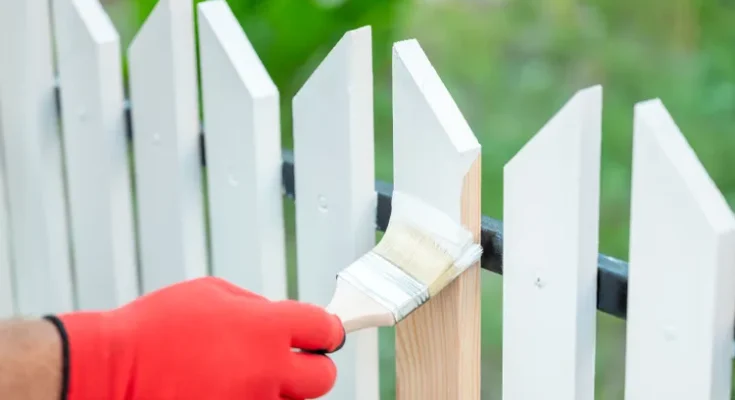Real estate and fencing experts say the answer isn’t simple.
Of all the costly outdoor groundskeeping on the to-do list, refreshing a fence might seem like light work. However, if it separates your property from the one next door, updating it with a fresh coat of paint or stain might not be so straightforward. Although changing the part that faces your house is tempting, you must determine who actually owns the fence and whether you have the legal or neighborly right to paint it. Altering a shared fence without permission can lead to legal disputes, homeowner association (HOA) penalties, and unpleasant interactions with neighbors.
Luckily, fence ownership debates can be resolved amicably, but there’s an art to negotiating shared costs and exploring alternatives to maintain the peace.
Determine Who Owns the Fence
Determining who owns a fence that divides two properties isn’t always straightforward. Jeff Lichtenstein, CEO and broker at Echo Fine Properties, says it depends on each state and county’s rules as well as whether you belong to an HOA. A land surveyor or a legal agreement might resolve the issue.
Not every fence is positioned exactly along property lines. If the fence is on just one owner’s land, then that owner owns it.
What if you hate the way it looks facing your property? “Even if it’s facing your property, it’s no different than a neighbor’s blue house facing your property,” Lichtenstein says. “The side of the house is what you see, and the owner doesn’t usually see it. Still, you can’t paint it whatever color you wish.”
Property surveys are often the most reliable way to determine where your land ends and your neighbor’s begins. In neighborhoods without HOA regulations or clear agreements, it’s best to obtain explicit permission before undertaking any action that might alter a structure your neighbor legally owns.
If you can’t stand the condition or color of the fence facing your home, then you need to start a delicate negotiation.
Negotiate with Your Neighbor
Zach Peyton, brand president of Superior Fence & Rail, jokingly references the famous Robert Frost line, “Good fences make good neighbors, right?” Wrong. He says that a few considerations make all the difference.
There may be cases when ownership can’t be easily established because neither neighbor has the original paperwork or the ability to schedule a property boundary survey. This may happen if neighbors had disputes in the past, if the land is rural or farmland, or if either property is part of an estate sale.
In any case, if one neighbor paid for the original fence outright, that generally indicates ownership of the fence. However, if costs are shared or unclear, open and honest communication can help prevent future conflict.
Peyton outlines a common scenario: “Mr. Smith wants to replace the fence during a larger backyard renovation, but Mrs. Jones, who technically owns it, doesn’t have the budget for it right now. If Mr. Smith is eager to proceed and has permission from the fence owner, he may opt to take on the full financial burden of replacing the fence. In that case, the new fence would belong to Mr. Smith.”
In other words, if your half of the fence bothers, you might have to take on 100% of the responsibility for a fix that serves both you and the neighbor.
Who Pays for the Paint Job?
Cost-sharing can be a delicate issue. According to Lichtenstein, the simple rule of thumb is: “If you really want something, offer to pay for the entire job.” He explains that this approach usually removes friction, especially if the neighbor isn’t particularly concerned with aesthetics. “They get a benefit out of it, but it doesn’t require them to invest.”
On the flip side, painting a fence without permission—even if you foot the bill—can backfire. Plain wooden fences may require a simple DIY coat of paint, but painting wrought iron, lattice, or brick fencing could damage the material irreversibly. Lichtenstein warns that homeowners who alter a fence without consent risk more than just neighborly tension. “You could be fined by the HOA, sued by your neighbor, and have legal penalties and judgments against you,” he says. What starts as a cosmetic improvement could become an expensive legal issue if the fence is ruined or the installation somehow affects your neighbor’s yard or lawn.
Best Practices and Fence Alternatives
“I tell every homeowner we know to buy their new neighbors a cookie cake and introduce yourself,” Lichtenstein says. While it may sound like a small gesture, taking the time to talk, explain your reasons, and ask questions can go a long way toward maintaining a collaborative approach.
If you and your neighbor can’t agree, sometimes the best solution is to leave the fence as is. Create a new kind of boundary. Hedges, tall grasses, and trellises with climbing plants can provide privacy without encroaching on shared structures. “With hedges, it’s more common that you take care of your side and they, theirs,” Lichtenstein says, which can help avoid future fence disputes.
If you have outdoor pets to protect, you may need to create other barriers on your side of the property line. Hardscaping or a secondary fence might be a suitable alternative.
Remember, if the fence condition poses a hazard to your health—think broken slats, exposed sharp metal, or chipping toxic paint—take it up with your HOA or municipality to broker a long-term remedy.



